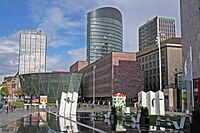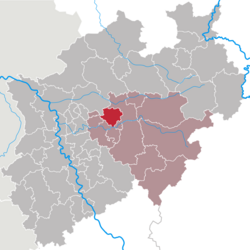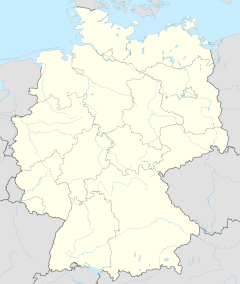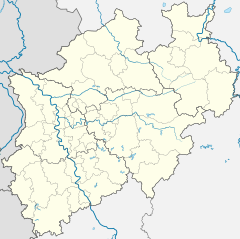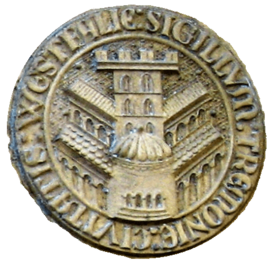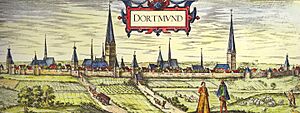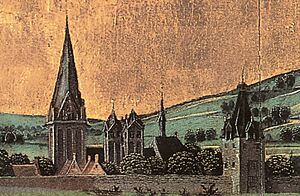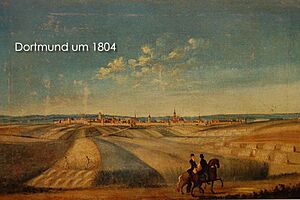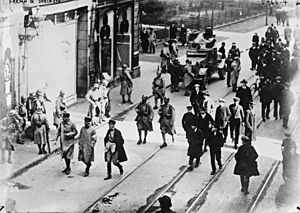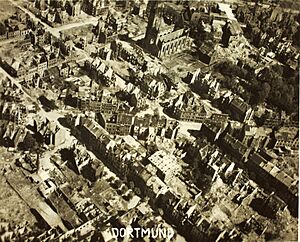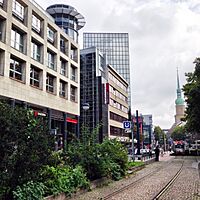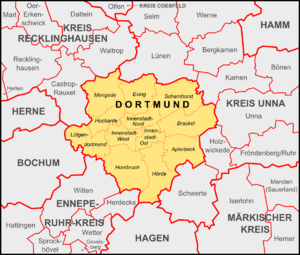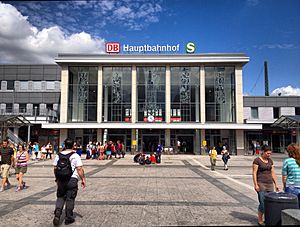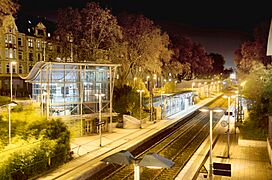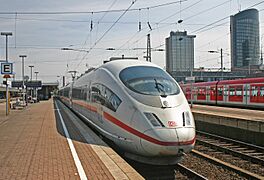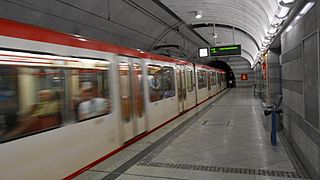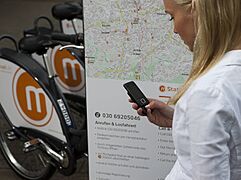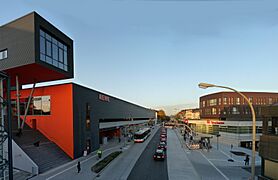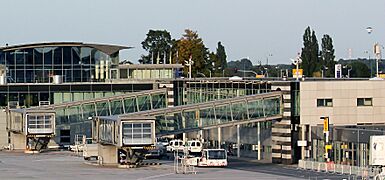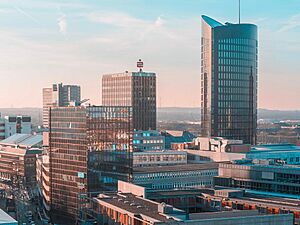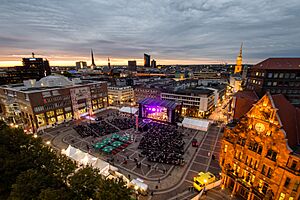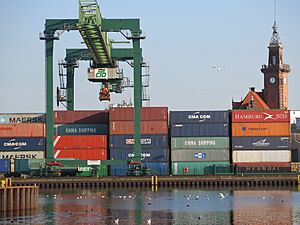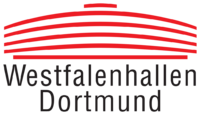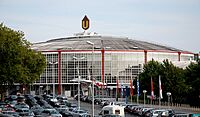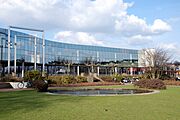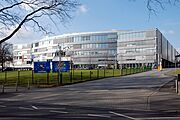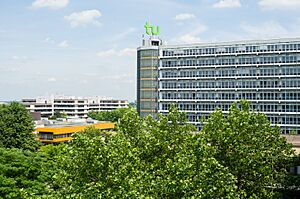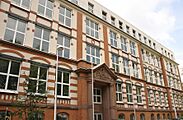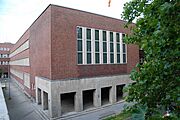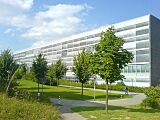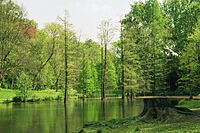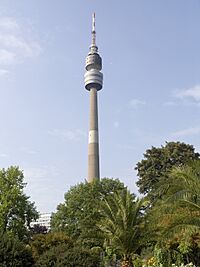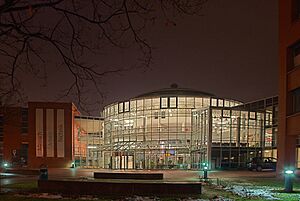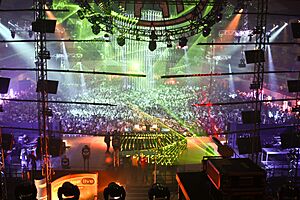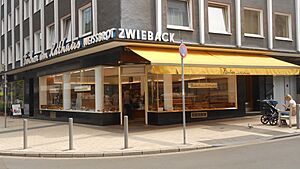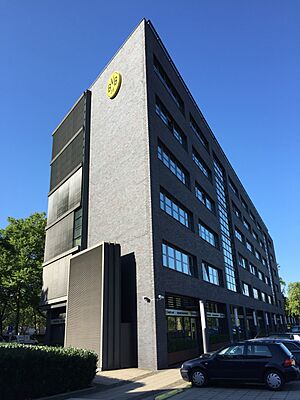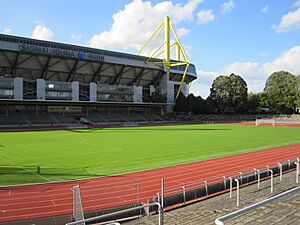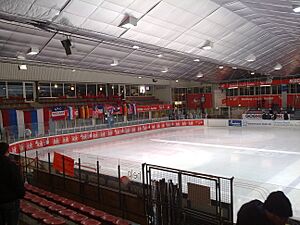Dortmund facts for kids
Quick facts for kids
Dortmund
Düörpm (Westphalian)
|
|||
|---|---|---|---|
|
Clockwise from top left: Bodelschwingh Castle; Opera House; Altes Stadthaus; old market square with St. Reinold's Church; Zollern II/IV Colliery; Dortmund U-Tower; and city centre
|
|||
|
|||
| Country | Germany | ||
| State | North Rhine-Westphalia | ||
| Admin. region | Arnsberg | ||
| District | Urban district | ||
| Founded | 882 | ||
| Area | |||
| • City | 280.71 km2 (108.38 sq mi) | ||
| • Metro | 7,268 km2 (2,806 sq mi) | ||
| Elevation | 86 m (282 ft) | ||
| Population
(2022-12-31)
|
|||
| • City | 593,317 | ||
| • Density | 2,113.63/km2 (5,474.28/sq mi) | ||
| • Urban | 5,302,179 (Ruhr) | ||
| • Metro | 11,300,000 (Rhine-Ruhr) | ||
| Time zone | UTC+01:00 (CET) | ||
| • Summer (DST) | UTC+02:00 (CEST) | ||
| Postal codes |
44001-44388
|
||
| Dialling codes | 0231, 02304 | ||
| Vehicle registration | DO | ||
Dortmund is a big city in North Rhine-Westphalia, Germany. It's the third largest city in its state and the ninth largest in Germany. Dortmund is also the biggest city in the Ruhr area, which is a large group of cities. It sits on the Emscher and Ruhr rivers.
Dortmund was founded around the year 882. It became a special "Imperial Free City," meaning it was self-governing. For a long time, it was an important trading city in the Hanseatic League. Later, it became a major center for coal, steel, and beer. During World War II, much of the city was destroyed, but it was rebuilt.
Today, Dortmund has changed a lot. Instead of coal and steel, it focuses on high-tech industries like biomedical technology and micro systems technology, as well as services. It's known as an "innovation city" and is considered a very sustainable and digital city in Germany. Dortmund is also a key transport hub with a big train station, an airport, and Europe's largest canal port.
The city is home to many cultural and educational places, including the Technical University of Dortmund and several museums. Nearly half of Dortmund is made up of green spaces, like parks and woodlands, which is quite unique for a city that used to be so industrial. Dortmund is also famous for its football club, Borussia Dortmund, which is one of Germany's most successful teams.
Contents
History of Dortmund
Dortmund has a long and interesting history, going back over 1,100 years!
What's in a Name?
Dortmund was first mentioned in old writings around 882. Back then, it was called Throtmanni. Over time, its name changed many times, like Trutmania and Tremonia. In the 13th century, the name Dortmunde started to appear, which is closer to what we call it today.
In the Middle Ages, after the city survived a big attack in 1389, people started saying, "So fast as Düörpm," which means "as firm as Dortmund." This saying is still used today to show how strong and resilient the city is.
Early Days
Long ago, there was a hillfort called Sigiburg near Dortmund. It was an important place during the Saxon Wars in the 700s. The first official mention of Dortmund itself was around 882 as Throtmanni. Important meetings, like church councils and imperial diets, were held here in the early 1000s.
Middle Ages and Beyond
After a big fire, the Holy Roman Emperor Frederick I (Barbarossa) helped rebuild Dortmund in 1152. The city grew into an important center in Westphalia. In 1293, Dortmund became one of the first cities in Europe to have an official right to brew beer!
From the 1200s to the 1400s, Dortmund was a "chief city" of the Hanseatic League, a powerful group of trading cities. This made Dortmund very wealthy and important. Did you know that in the 1300s, the English King Edward III even borrowed money from rich Dortmund families, using his crown as security?
In 1388, Dortmund faced a huge siege that lasted 18 months, but the city won! This showed how strong it was. Later, in 1543, one of Europe's oldest schools, the Stadtgymnasium Dortmund, was founded here.
18th, 19th and Early 20th Centuries
In 1803, Dortmund stopped being a free city and became part of other territories. In 1815, it became part of the Kingdom of Prussia. This was a big change for the city.
During the industrialisation period in Prussia, Dortmund grew very quickly. It became a major center for coal mining and steel production. The population jumped from about 57,000 in 1875 to nearly 380,000 in 1905! New neighborhoods were built very fast. In the 1920s, Dortmund was a place of resistance against political changes in Germany.
World War II and Rebuilding
During World War II, Dortmund was heavily bombed because of its important industries. On March 12, 1945, there was a huge bombing raid that destroyed 98% of the buildings in the city center. It was one of the largest bombing raids on a single target in the war.
After the war, the city center was almost completely rebuilt in the style of the 1950s. Many historic buildings were lost, but some important churches like the Reinoldikirche and Marienkirche were restored. Today, about 30% of the city's buildings are from before World War II. Dortmund became part of the new state of North Rhine-Westphalia in 1946.
The coal mining industry in Dortmund ended in 1987. Since then, the city has changed its focus to high-tech industries like biomedical technology and services. This has made Dortmund a center for new technologies.
A big project called Phoenix See started in 2001. It turned an old industrial area into a beautiful lake and a new living and recreation space. In 2013, a large unexploded bomb from World War II was found and safely removed, showing how much the city has recovered.
Geography
Dortmund is located in the eastern part of the Ruhr area, which is one of the largest urban areas in Europe.
Where is Dortmund?
Dortmund is an independent city, meaning it governs itself. Its borders are about 87 kilometers (54 miles) long and touch twelve other cities. Historically, Dortmund is part of Westphalia. The city is in a flat area called the Westphalian Lowland, but to the south, it meets the Ardey Hills.
The Ruhr River forms a reservoir called the Hengsteysee in the south of Dortmund. The highest point in Dortmund is the Klusenberg hill, which is 254.3 meters (834 feet) high. The lowest point is in the northern part of Brechten, at 48.9 meters (160 feet). The Emscher River also flows through Dortmund, starting east of the city.
City Areas
Dortmund is divided into 62 neighborhoods, which are grouped into twelve larger areas called "Stadtbezirke" (boroughs). Many of these boroughs used to be separate towns before they became part of Dortmund. This is why people in some boroughs, like Hörde, feel a strong connection to their local area and even have their own coat of arms!
The city center has many different districts:
- City Centre: This area shows a mix of old and new buildings because so much was rebuilt after World War II.
- Kreuzviertel: This district is known for its beautiful old buildings from the late 1800s and early 1900s. It's a popular and trendy area with many cafes, shops, and art galleries. The West park is a green space where students like to relax.
- Nordstadt: This northern part of Dortmund is a lively area with many different cultures. It has a lot of older buildings and was once an industrial hub. It's home to two parks, Fredenbaumpark and Hoeschpark. The Borsigplatz, a famous square, is where the Borussia Dortmund football club was founded.
- Kaiserviertel: Located east of the old city walls, this district has grand buildings from the 1900s. It's known for its "Cherry Blossom Avenue" (Moltkestreet), which becomes very beautiful in spring.
- Unionviertel: This area west of the old city walls has become a hub for young artists and students. The Dortmund U-Tower, a former brewery now an art center, is a key landmark here.
- Hörde on Lake Phoenix: Hörde used to be a separate town. Today, it's famous for Lake Phoenix, a huge urban development project built on an old steel plant site. It's a beautiful area with new homes and a city port. The Emscher River, which flows nearby, is also being restored to be more natural.
Weather in Dortmund
Dortmund has a mild climate. Winters are cool, and summers are warm. It rains fairly evenly throughout the year.
Cityscape
Dortmund's city center is a mix of old and new. Because 98% of it was destroyed in World War II, much of it was rebuilt in the 1950s style. However, the streets still follow the old medieval layout. The Westen-/Ostenhellweg is a main pedestrian street that used to be a medieval salt trading route.
Some buildings from the rebuilding era, like the opera house, are now seen as important examples of modern architecture.
Churches of Dortmund
Dortmund has many historic churches:
- Reinoldikirche: A Protestant church built between 1233 and 1450.
- Petrikirche: A Protestant church started in 1322, famous for its large carved altar called the "Golden Miracle of Dortmund."
- Marienkirche: A Protestant church originally built in the late 1100s, rebuilt after World War II.
- Propsteikirche: A monastery church built between 1331 and 1353.
- St. Peter in Syburg: The oldest church building in the city.
Castles and Historic Houses
Dortmund has several old castles and houses, some surrounded by water (moated castles):
- Haus Bodelschwingh (13th century)
- Haus Dellwig (13th century)
- Haus Rodenberg (13th century)
- Altes Stadthaus (built in 1899)
- Romberg Park Gatehouse (17th century), now an art gallery.
- Husen Castle, a tower house from an old castle.
Industrial Heritage Buildings
Many of Dortmund's industrial buildings are part of the Industrial Heritage Trail, which connects important industrial sites in the Ruhr area.
- U-Tower: A former brewery, now a museum and creative center.
- Zollern II/IV Colliery: An old coal mine, now part of the Westphalian Industrial Museum.
- Hansa Coking Plant: A large industrial plant.
Cultural Buildings
Dortmund has many places for arts and culture:
- Konzerthaus Dortmund: A famous concert hall.
- Opernhaus Dortmund: The opera house, built in 1966 on the site of an old synagogue.
- Museum für Kunst und Kulturgeschichte: A museum of art and cultural history.
- Museum Ostwall: A museum of modern and contemporary art, located in the U-Tower.
- German Football Museum: The national museum for German football.
Other Important Buildings
- Florianturm: A tall television tower.
- Westfalenstadion: The home stadium of Borussia Dortmund, also known as Signal Iduna Park. It's the biggest football stadium in Germany.
- Westfalenhallen: A large convention center near the stadium.
Tall Buildings
Dortmund has several tall buildings, including:
- Florianturm (266 meters / 873 feet)
- RWE Tower (100 meters / 328 feet)
- Westnetz Hochhaus Dortmund (100 meters / 328 feet)
- Westfalentower (88 meters / 289 feet)
Getting Around Dortmund
Dortmund is a major transport hub in Germany.
Roads and Cycling
The city is connected by major highways, including the A1, A2, and A45, which form a ring around Dortmund. The Ruhrschnellweg (Ruhr Fast Way) connects Dortmund with other cities in the Ruhr area.
Dortmund also has a good network of bike paths and is part of a long-distance cycle path called the Radschnellweg Ruhr (Ruhr Area Fast Cycle Path).
Trains and Public Transport
Dortmund's central train station, Dortmund Hauptbahnhof, is one of the busiest in Germany. You can catch high-speed trains (ICE and Thalys) to other German cities and even to Amsterdam, Brussels, and Paris.
Within the city, Dortmund has a great public transport system with a light rail (Stadtbahn) and buses. The light rail has eight lines, and some parts run underground. There are also night buses on weekends.
The H-Bahn at the Technical University of Dortmund is a special hanging monorail that connects the university's two campuses.
Air and Water Transport
Dortmund Airport is a growing airport located east of the city. It offers flights to many European cities.
Dortmund Harbour is the largest canal port in Europe. It connects Dortmund to the North Sea through the Dortmund-Ems Canal, making it an important place for shipping goods.
- Transport in Dortmund
-
ICE 3 at Dortmund Hauptbahnhof
Economy and Business
Dortmund's economy has changed a lot. It used to be all about steel, coal, and beer. Now, it's a leader in high-tech fields like robotics, biomedical technology, and micro systems technology. It's also strong in engineering, tourism, finance, and services.
Many smaller and medium-sized companies are based in Dortmund. The city also has a large number of information technology (IT) companies, many linked to the Technical University of Dortmund at the "Technologiepark Dortmund." This park is one of the most successful technology parks in Europe, with around 280 companies and over 8,500 employees. Dortmund is one of Germany's biggest software locations.
Big companies like Signal Iduna (insurance), Rhenus Logistics, and Wilo have their headquarters here.
Tourism in Dortmund
Tourism is growing fast in Dortmund! The city has worked hard to become a vibrant place for visitors. Key attractions include the Konzerthaus Dortmund, the Zollern II/IV Colliery (an old mine), the Dortmund U-Tower, and the famous Dortmund Christmas market.
The Christmas market is especially popular, attracting over 3.5 million visitors with its 300 stalls and a giant 45-meter (148-foot) tall Christmas tree, said to be the biggest in the world! Other popular spots are Signal Iduna Park (the football stadium), the German Football Museum, and Westfalenpark.
Shopping in Dortmund
The Westenhellweg is a very popular shopping street. It's a pedestrian-only area with many well-known shops and department stores. During the Christmas season, it hosts the huge Dortmund Christmas Market.
Other shopping areas include the Thier-Galerie mall and the Brückstraßenviertel, which is popular with young people. The Kleppingstraße is known for its fancy shops and restaurants.
Port and Logistics
Dortmund is a very important place for logistics (moving and storing goods) in Germany. The Dortmund Port is the largest canal port in Europe. Many big companies like Amazon, IKEA, and Decathlon have large logistics centers here.
Fairs and Exhibitions
Dortmund is home to the Halls of Westphalia, a big exhibition center. It hosts many important fairs, like "Jagd & Hund" (hunting and dogs), which is the largest of its kind in the world. "Intermodelbau" is the world's biggest fair for model making.
Education and Research
Dortmund has many schools and colleges, teaching over 85,000 students. The Stadtgymnasium Dortmund, founded in 1543, is one of the oldest schools in Europe.
Universities and Colleges
- Technical University of Dortmund (TU Dortmund): Founded in 1968, it has about 30,000 students and offers many subjects like physics, engineering, and economics. It's known for its strong research.
- Dortmund University of Applied Sciences and Arts: This university has about 12,300 students and different campuses around the city.
- International School of Management: A private school focused on business and management.
Research Institutions
Dortmund is home to many famous research institutions, like the Fraunhofer Society and the Max Planck Society. These places do important scientific research, often working with the universities.
Life in Dortmund
Dortmund is considered a great place to live. Studies have shown it's one of the most livable cities in Germany, especially for students and expats. It's praised for its quality of life, good public transport, and many opportunities for sports, food, and shopping. It's even ranked as one of the least stressful cities in the world!
Culture
Dortmund has a rich history of music and theater. The Dortmunder Philharmoniker orchestra was founded in 1887. The Opernhaus Dortmund (opera house) and the Konzerthaus Dortmund are major venues for performances. The Konzerthaus is even listed as one of the best concert halls in Europe!
The Domicil Jazz Club is known as one of the "100 best jazz venues worldwide." The Dortmund U-Tower, once a brewery, is now a center for creative arts.
Dortmund is also famous for its Christmas market, which attracts millions of visitors each year. It's known for its handmade decorations and delicious food.
Parks and Recreation
Dortmund has many beautiful green spaces:
- Botanischer Garten Rombergpark: A huge botanical garden and arboretum (a place for trees) in the south of the city. It's one of the largest botanical gardens in the world, with thousands of plant species.
- Dortmund Zoo: Located next to Rombergpark, this zoo has 1,800 animals from 250 species. It's known for breeding South American animals like giant anteaters and otters.
- Westfalenpark: Dortmund's most popular inner-city park, covering 72 hectares. It has a rose garden, theme gardens, cafes, and recreation areas. The Florian tower in the park offers amazing views of the Ruhr valley. The park also hosts events like the Juicy Beats music festival.
Museums in Dortmund
Dortmund has over 20 museums, offering a wide variety of topics.
- Museum am Ostwall: A museum of modern and contemporary art, located in the Dortmund U-Tower. It has works by famous artists like Pablo Picasso and Joan Miró.
- German Football Museum: The national museum for German football, located near the main train station. It tells the story of German football and the Bundesliga.
- Museum für Kunst und Kulturgeschichte: This museum shows the cultural history of Dortmund from ancient times to the 20th century.
- Steinwache: A memorial museum in an old prison. It shows the history of resistance and persecution during the Nazi era.
Other important museums include:
- DASA – Arbeitswelt Ausstellung (Germany Occupational Health and Safety Exhibition)
- Borusseum (Museum of Borussia Dortmund)
- LWL Industrial Museum Zollern II/IV Colliery (Germany's first technical building monument of international importance)
- Brewery Museum
Festivals and Nightlife
Dortmund has a lively nightlife with many restaurants, bars, and clubs. It's also a big center for electronic dance music and techno, hosting major festivals like Mayday and Syndicate at the Westfalenhalle Arena.
The Juicy Beats music festival in Westfalenpark attracts over 50,000 visitors each year with its mix of pop, rap, electro, and other music styles.
Dortmund Cuisine
Traditional foods in Dortmund include Pfefferpotthast (a type of goulash), Himmel und Äd (black pudding with apples and mashed potatoes), and Currywurst. In summer, people enjoy Dortmunder Salzkuchen (bread buns with caraway seeds, salt, meat, and onions). In winter, Reibekuchen (fried potato pancakes with apple sauce) are popular.
Dortmund is famous for its beer, especially Dortmunder Export, a pale lager. It has a brewing tradition of over 550 years! Many old breweries were founded around the Old Market. A special small beer, called a "Stösschen," is also a local tradition.
Sports in Dortmund
Dortmund calls itself the "City of Sports." It's home to the world's biggest handball association, the German Handball Association (DHB), and the German professional handball league.
Football
Dortmund is most famous for its football club, Borussia Dortmund. They are one of Germany's most successful clubs, having won the Bundesliga many times, the UEFA Champions League in 1997, and the UEFA Cup Winners' Cup in 1966.
Borussia Dortmund plays at Westfalenstadion, also known as Signal Iduna Park. It's the largest football stadium in Germany, holding over 81,000 fans!
Other Sports
- Handball: Borussia Dortmund also has a women's handball team that plays in the top league.
- Table Tennis: The club has a table tennis team in the second Bundesliga.
- American Football: The Dortmund Giants are the city's American football team.
- Ice Hockey: The Eisadler Dortmund is the city's ice hockey club.
- Basketball: SVD 49 Dortmund is the city's basketball team.
- Baseball: The Dortmund Wanderers play in the top baseball league.
Dortmund also hosts the Dortmund Sparkassen Chess Meeting, a famous chess tournament, and has a horse racecourse.
Sister Cities
Dortmund is twinned with several cities around the world, meaning they have special friendly relationships:
Notable People
Many interesting people were born in Dortmund:
Born Before 1900
- Friedrich Arnold Brockhaus (1772–1823): A famous publisher who started the Brockhaus Encyclopedia.
- Wilhelm Lübke (1826–1893): An art historian.
- Wilhelm Canaris (1887–1945): An admiral and head of military intelligence.
Born After 1950
- Dietmar Bär (born 1961): A well-known actor.
- Florian Schwarthoff (born 1968): An Olympic bronze medalist in hurdles.
- Kevin Grosskreutz (born 1988): A football player.
- Marco Reus (born 1989): A famous football player for Borussia Dortmund.
- Lina Magull (born 1994): A football player.
Images for kids
See also
 In Spanish: Dortmund para niños
In Spanish: Dortmund para niños








